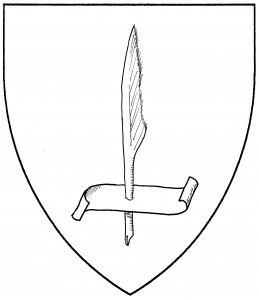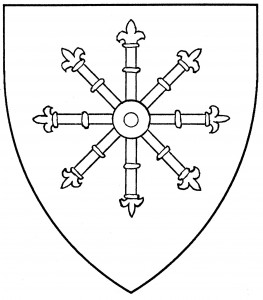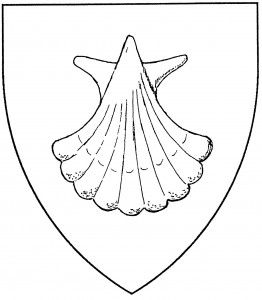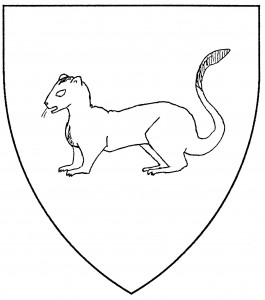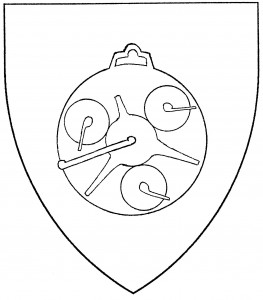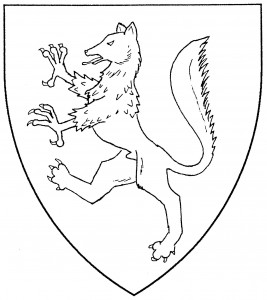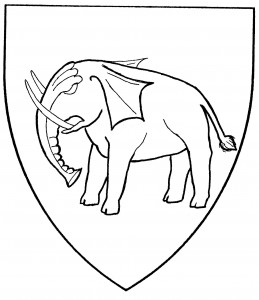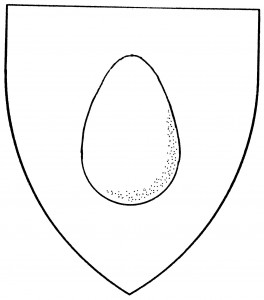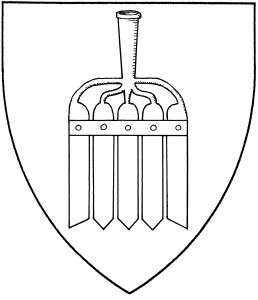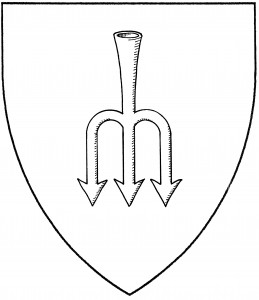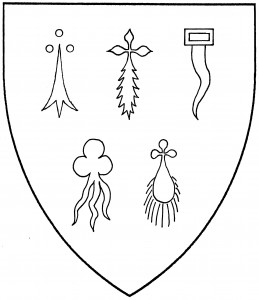
Five ermine spots (Period)
An ermine spot, or ermine tail, is a highly stylized charge, meant to represent the tail of the ermine beast; it is also sometimes blazoned a “muskatour”. Ermine spots were sometimes charges in their own right, as in the arms of Liesvelt, c.1460 [GATD 34v; also Gelre 83v]; but they are far more often found strewn across a field to form the heraldic ermine-style furs.
Of these furs, by far the most common was simply blazoned “ermine”: a white field with black ermine spots, most famous as the arms of the Dukes of Brittany, 1318 [Asp2 172]. For most of the Society’s period, this was the only ermine-style fur in use. In the 15th Century, a variant was introduced, a black field with white ermine spots [Hope 8]: it was called “ermines” in English and “contre-hermine” in French. To avert typos, Society blazons use the translation of the latter, “counter-ermine”.
Towards the end of period, two other ermine-style furs appeared in heraldic tracts [e.g., Legh 76]: “erminois”, a gold field with black ermine spots, and “pean”, a black field with gold ermine spots. Your Author has found a single period example of erminois, in the arms of Meery, c.1510 [DBA3 489; also Gwynn-Jones 98]; we’ve yet to find a period example of pean. However, on the basis of Legh if nothing else, all four of these furs are available for Society use.
Post-period examples exist of fields strewn with ermine spots, in other tinctures, e.g., “Gules semy of ermine spots Or” [Woodward 68]. Society practice would blazon this “Gules ermined Or”, and treat it as an ermine-style fur. Any metal field may be ermined in a color, and vice versa, in Society heraldry. We have a single example in an heraldic tract, the Traité de blason, late-15th C., of “Or ermined vert” (le champ dor armine de sinople), but no actual examples of its use in arms; nonetheless, this provides support for the practice in the Society.
The illustration shows several stylizations of ermine spot, which were taken from medieval emblazons. The one in dexter chief, from Legh, is the form most often found in Society emblazons. Naturally, an emblazon shouldn’t mix styles, but should use one stylization throughout. See also tail.
Adeliza de Clermont bears: Or, an ermine spot purpure.
Wilhelm Leopard der Schwarze bears: Sable, in chief five ermine spots in fess Or.
Alisaundre Caledon bears: Per chevron Or and sable, three ermine spots counterchanged.
